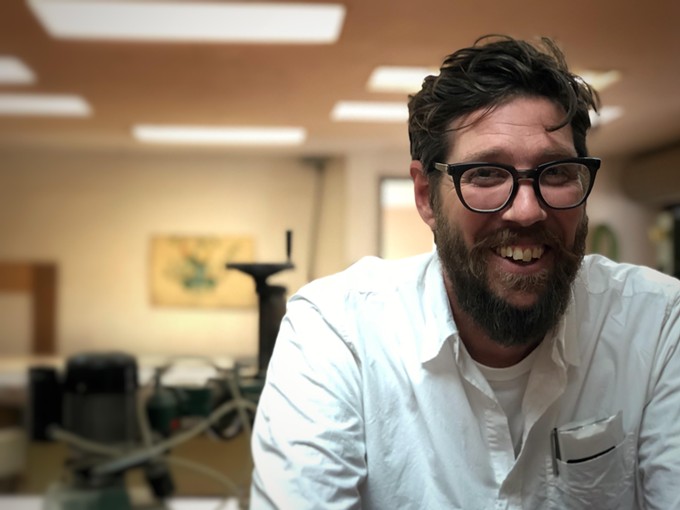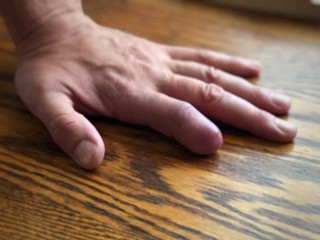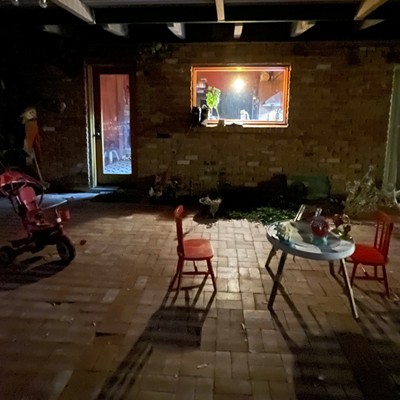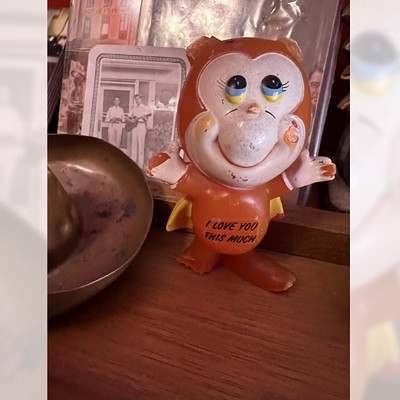John Peter Baer's inner child let loose: "Hospital. Bad ..."
Because while he wasn't paying attention, or maybe he was—it's somewhat hazy now—the aluminum jumped in his hands. Then it jerked into another momentum.
His bloodied hand shot up from the woodworking saw and flashed across his periphery, half of a forefinger severed and dangling by fleshy ribbons. Looked like a little scarlet flag.
"Hospital. Bad ..."
He nearly fainted from certain agony. A coworker rushed in, wrapped the forefinger and hauled Baer to the hospital.
Meantime, Baer's inner kid kept scolding its adult, "You weren't paying enough attention.... All the times you told me to suspend my disbelief, and you were wrong!"
A few weeks later Baer experiences the episode as fated. Any woodworker worth their salt is missing at least half a finger, or more. Right?
"An inch of flesh every 21 years," he says, gently laughing. "That's what we shall pay."
* * * *
Baer is lanky, early 40s, calm. Short, thick mane and beard, specs and crooked teeth. Today in his Baer Joinery shop, in Armory Park, he wears a clean, white button-down shirt. When we meet, I half wait for a touch on the shoulder as a benediction or something. He's sort of Jesus-y like that: a discernable inner-peace, thoughtful, well-spoken, etc. Makes him handsome. Or maybe that's just my own inner-romance of solitary artisans—men and women who create lovely "heirloom-quality" objects and space from exotic and reclaimed hard and softwoods, a skill borne of thousands of hours of personal isolation. Much respect.
He lifts his stubby left forefinger in the air, looks at it and says it continues to throb. The thing is bulbous and swollen with a soft violet-y hue. The severed half of the finger was too shattered to be surgically reattached. It's still healing.
He laughs, "feels like a very physical manifestation of things I've been through. A kind of aggregate."
His point is on. His Baer Joinery succeeded on the obliging ways he tended to his intuitions. And inspirations too, such as his 12-year-old daughter and 14-year-old stepson, both products of a marriage that recently, painfully, ended.
But you must learn your craft somehow. Malcom Gladwell's "10,000-hour rule"—the contention it takes 10,000 hours of "deliberate practice to become world-class in any field"—seems accurate. It takes at least that many (roughly three hours a day for 10 years) in the arts, in writing, in music. Baer passed that mark years ago. In fact, it's taken him a decade just to assemble the A-list craftsmen, artisans, sawyers, machinists, reclaimers who work with him now.
And his sawdusty and spacious two-story workshop is filled of things to favor: Beyond the drills, saws and lathes, there are a few beautiful in-progress pieces, and that smell in the air—a warm, sweetly virile mix of planed woods and machinery. Could be the exact scent of confidence.
Call it hyperbole or envy, but I'm long awed by anyone capable of creating beauty with their hands: the painters, the sculptors, the luthiers, the rare-wood craftsmen etc. It's like their touch has more sensation than my own, because they can manifest their inner turmoil and casualties into some kind of beauty, ideas and objects through which we can sometimes define ourselves.
And Baer Joinery work can often stun. Baer seems embarrassed when I say this aloud. "Well," he says, "you do work through things."
* * * *
Baer's a descendant of horsemen and farmers and millwrights and gunsmiths, and is the seventh-generation family woodworker. He was raised in a Mennonite family just outside of Archbold, a tiny town in northwest Ohio. Baer's pop worked in wood. His woodworker uncle still runs factories. His grandfather was a lifelong craftsman and cabinet maker. The childhood restored barn/farmhouse had 10,000 chickens at one point, and they grew most of their own produce.
At 15 or so he used music to get out of Ohio. He'd gotten into fusion jazz, which he picked up from a Mexican family in his hometown, and he built his own five-string bass, his first successful woodworking project. He toured the Midwest briefly playing bass in a country band. Baer remembers his dad dropping him off at the bandleader's house—a mobile home in the hills with toys scattered all around it.
"I already had so little respect for small-town teachers," he says. "Sports were the main thing. I would've had to get into trouble to save my soul."
He wound up in Texas in his late teens, directionless. There he learned much "about life and simplicity of craftsmanship, natural lines" from a few woodworkers, in particular a world-renowned luthier named Christopher Savino. He'd say things like, "'there is no perfect radius in nature.' So at 19, I was having these existential lessons—and he was just trying to get the work done as quickly as possible."
He followed one brother to Tucson, who was doing Community Home Repair, a Mennonite volunteer service, and he began working in 1996. The Baer Joinery went totally official in 2013; he was no longer winging it as a woodworker.
The Baer Joinery is a sort of reflection of the man, too. No stereotypes of angry white dudes in filthy khaki and diabetic guts listening daily to Rush Limbaugh and Fox News. One of Baer's own passing remarks is telling: Baer Joinery is populated by, he says, "good-looking male feminists." If you say shitty things about women, you'll never work here.
Mostly he's learned to become the face of the company, the mouthpiece. The company needs, by his rough estimation, $30K a month to stay afloat. And they make it; word-of-mouth ensures it. You can spot the Baer Joinery works, their cabinetry, doors, metal works and architectural designs, because it's born of a guy who's still creating, by hand, things his family has been making for generations from traditions handed down. It's not just anywhere.
But you can in dozens of places in Arizona, from elaborate restorations at St. Paul's Episcopal and the courthouse in Tombstone, for example, to Hotel Congress and the Desert Museum. Private residences. Circular staircases custom designed with graceful curved pieces, multilayered ceilings, windows, beams and trusses. Space-defining architectures of quiet ambitions, central-to-Arizona identities of sun-warm colors and wood, and history.
For years, they worked on a private residence in Tubac, assisted the owner through several conmen contractors/architects, restoring and replicating wood traditions. Lots of reclaimed sassafras, old teak, softwood species, mixed-timber hardwoods, some even
from his hometown in Ohio. Some beams were made by the same person who made the beams in the house he grew up in, beams Baer would gaze at as a kid dreaming.
There are five employees including Baer. Two more coming soon. These are dudes who haul ergonomic chairs to jobsites and place them around the backs of pickups for lunch break, eating organic blueberries and clementine oranges and lavash crackers decorated with various cheeses. Picturesque as an L.L. Bean catalogue. They're so at home in the outdoors, the woods. Believe it or not, there's harmony among them.
"It's sort of 'lumber-sexual,'" Baer laughs. "That's the one I heard. But that may be more of a Portland thing." But Baer sounds grateful. "I learn something every day in that shop," he says.
The place is closer to a kind of socialism operating inside a capitalist world. There's no advertising, lobbying or dividends paid.
Baer and his employees all make roughly the same money, and they're all paid a living wage in the $40K-$50K range, not bad for old penurious Tucson. Baer recognizes some employees are more capable at different stages of the year, different stages of their lives, the human ebb and flow. Some may stay with Baer for life. The owner certainly hopes so.
There's contradiction. He speaks authenticity versus capitalism—an age-old work and art versus security, commerce and capital goods. He speaks mathematics, problem-solving, philosophy, work as meditation, merits of raising children without device screens, and of the various dialects of Tohono O'odham nation. He can talk joinery all day, dado joints verses dovetail, the merits of antiquated German block planes, wood species from far-off lands and the importance of reuse in the face of vanishing forests.
He knows he works a luxury trade. I make the argument he's contributing to a greater good. You see the work, in public spaces and the artfulness helps to understand slightly different ways of perceiving the world ...
"It doesn't fit any need in terms of food, water, clothing and shelter," he says. "You have to think of Houston or Puerto Rico or Syria. I haven't built anything anyone really needs. Emotional needs, maybe. Even then it's because they might need something else. The best I can do right now is pay people a living wage, in the first world."
In a country that saw, in the last 15 years, about 65,000 U.S. factories closed—machine-tool manufacturers, furniture-producing mills etc. Where you can get any plywood thing at Ikea made in China. Sounds corny, but there's humanity here. I've heard the guy talk customers out of spending large sums of money if it's not in their best interest.
"For me," he says, "it's a challenge going into those situations and noticing so much about someone and their environment."
* * * *
A sizable peacock roams the fenced space between the two-story joinery and the railroad tracks. She strolled in one day and stayed, and she's watered and fed. A hen recently died of old age here too, and there's a squirrel on residence and a beehive. There's organized piles of lumber and machinery around a green, graffiti-tagged storage container, bigger than a railroad freight car. Industrial beauty in its own eco-system.
A Union Pacific train trudges by, yellow engines, rust and graffiti-tinted cars clacking behind, a rolling source of Tucson sustenance, inspiration and otherwise. Baer calls it "dreamy. It's a moving wall of color."
There's still some sadness about the divorce from three years ago, but he hardly sulks or rears against anything—he seems fascinated by life and living, its wonders, exasperations. His works show it. And here's a guy who says with no irony that his definition of success would be donating all money from his work to orphanages in Africa, or someplace similar.
Creating from wood, it's his inner kid, the severed finger, this constant cutting away to arrive at a whole.














